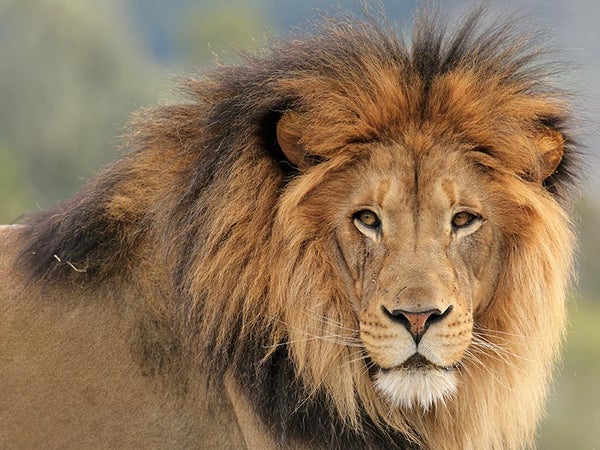This article was published in Scientific American’s former blog network and reflects the views of the author, not necessarily those of Scientific American
Here’s roaring good news: In a move several years in the making, the U.S. Fish and Wildlife Service today finally announced that the African lion (Panthera leo) would formally be protected under the U.S. Endangered Species Act.
Specifically, the nearly extinct lions of western and central Africa—a subspecies now called P. l. leo—will be listed as endangered. Only about 1,400 of these lions remain scattered across more than a dozen countries, including the critically endangered Asiatic lions of India (the cats on the two continents were not previously considered the same subspecies). Another lion subspecies—P. p. melanochaita of east and southern Africa—will be listed as threatened. There are about 17,000 to 19,000 lions left in this subspecies, most of which live in protected but restricted habitats.
In a press conference, FWS director Dan Ashe called lions “iconic,” “a part of our culture,” and one of the most beloved wildlife species on the planet.
On supporting science journalism
If you're enjoying this article, consider supporting our award-winning journalism by subscribing. By purchasing a subscription you are helping to ensure the future of impactful stories about the discoveries and ideas shaping our world today.
Ashe called the ESA listing an important step to setting a new course for African lions, which are projected to lose another 50 percent of their populations over the next 20 years. The total lion population was estimated about half a million at the begining of the Twentieth Century.
Lions in Africa face many threats, including habitat loss, prey depletion and retaliatory killings for livestock depletions. The endangered species listing will help to tackle another threat, the so-called “sports” hunting of lions like we saw with the famous case of Cecil earlier this year. Ashe said the listing will not bar the import of trophies from these hunts into the U.S., but it will “raise the bar significantly” and require permits that prove any hunts were conducted in a sustainable manner. Countries which allow hunting will need to prove to FWS that their programs actually enhance and protect wild populations—for example, by funding local communities and ensuring that lions do not pose a perceived threat to livestock—before any trophies from those hunts could be imported into the U.S.
Ashe also used the authority of his office to order that anyone who has previously violated wildlife laws in the U.S. or abroad be barred from receiving all future import permits for any wildlife species. This would include people like the dentist who shot Cecil the lion.
Although the majority of Ashe’s discussion focused on hunting, the ESA listing also frees up resources to help address other threats to lions, including poaching and illegal trafficking or lion parts. A proposed increased fee for trophy imports will help to improve enforcement actions across the board. The ESA listing would also limit and require permits for the currently unrestricted interstate trade in captive African lions within the U.S. and place new restrictions on the commerce of lion bones and other derivative products, according to FWS spokesperson Vanessa Kauffman.
Conservation groups praised the ESA listing, while also pointing out that a lot of additional work is needed to save wild lions. “Trophy hunting is only one small factor contributing to the lion’s current status,” said Luke Hunter, president and chief conservation officer of Panthera, an organization devoted to protecting the world’s big cat species. “While today’s bold actions are welcome, they will not stem the rapid decline of the species brought on by far more pressing and pervasive threats, especially the illegal bushmeat industry that empties African savannahs of wildlife, and the widespread killing of lions by people in defense of their livestock. Lions have already disappeared from 22 countries in Africa. Reversing this tragic pattern will require the many local, national and international stakeholders in the lion’s future to commit to its protection on a grand scale.”
The new rules go into effect on Jan. 22, 2016.
Previously in Extinction Countdown:
Lions in Peril: Big Cats Face 50 Percent Decline in Next 20 Years
African Lions Face Extinction by 2050, Could Gain Endangered Species Act Protection
Shocking Study Finds Lions are Nearly Extinct in West Africa
Lion Meat Tacos (You Read That Right) Are the Latest Threat to Conservation
DNA Reveals the Last 20 Ethiopian Lions Are Genetically Distinct
Lions vs. Cattle: Taste Aversion Could Solve African Predator Problem
Also by John R. Platt:
